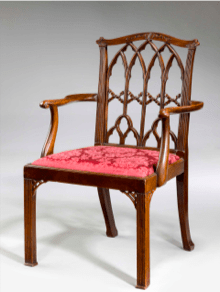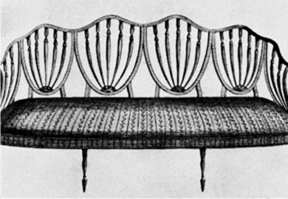Blog
Keep up to date with the latest news from art markets across the world through our blog "the eye of the expert"
Any questions?
contact@mr-expert.com
How to identify antique english furniture?
The 18th century was the great period of splendour for English furniture: the rich and cultured aristocracy of the Grand Tour had villas built surrounded by beautiful gardens, acquired art collections and wanted brand new furniture that followed the fashions of the time.
The cabinetmakers thus followed aesthetic developments, while maintaining a very high level of workmanship and refinement that contributed to the fame of 18th century English furniture, particularly in the work on mahogany, of which the two greatest representatives were Thomas Chippendale (1718-1779) and Georges Hepplewhite (1727-1786), recognised thanks to the distribution of their books of models.
The 17th century legacy and the Queen Anne style
The Queen Anne style lasted long after the end of the sovereign’s reign, until the 1720’s. This style is heir to the models of the previous century and draws its forms from Dutch furniture, with one English characteristic however: the replacement of oak by imported walnut, which allows for finer designs.
As far as the decorations are concerned, the cabinetmakers made great use of veneer, which forms symmetrical patterns, and then let themselves be tempted by the technique of marquetry and in particular the marquetry arabesque which was very much in vogue at the beginning of the century. At the same time the very original plaster furniture also appeared. The plaster is applied to the wood and then hollowed out to form decorations, sometimes it is even structural thanks to the reinforcement of a metal rod. The greatest exponent of this technique is James Moore who, a rare occurrence for a craftsman at the time, engraved his name on his furniture. Finally, like France, England, has also fallen in love with lacquer oriental ; cabinetmakers apply it to furniture in slabs or try to imitate it, with quite a bit of success.

As for the shapes of the furniture, the seat underwent a significant evolution in the last years of the 17th century, with the introduction of the Cabriol leg and the claw and ball foot, the foot with a sphere and claw which is perhaps derived from the Chinese model of the dragon’s paw holding a sphere. The backs of the seats and sofas are fairly wide and flat. The Queen Ann style also saw the immense success of desks whose bodies were gradually becoming less imposing and with the legs becoming thinner.
The great cabinetmakers of this period are Daniel Marot, a French Protestant who fled religious persecution, Gerrit Jensen, a cabinetmaker of Flemish origin whose name is sometimes anglicised to Johnson, and Jean Pelletier, a Frenchman specialising in bronze and gilding.
Georgian style
The Georgian style is a term used to refer to the period covering the reigns of four rulers named George for almost a century. During this period, several styles succeeded one another. The first, the early Georgian, between 1714 and 1760, established the main characteristics of the furniture in the 18th century. One of the great revolutions was the advent of mahogany, which replaced walnut around 1720 due to the French embargo on the export of walnut to England. This change influenced the design and decoration of the furniture and caused the abandonment of marquetry and carved decorations: silver or gold were preferred, as they were better suited to mahogany. The pieces also become lighter and more openworked, as the wood is very solid.
This period is that of the intimate alliance between interior decoration and overall interior furnishings, of which architect William Kent is the greatest exponent in the first half of the century. A member of Lord Burlington’s neo-Palladian circle, he built homes that were very sober on the outside and exuberant on the inside, in the taste of Italian Baroque. He collaborated on the greatest building sites of his time, such as Holkam Hall, where most of the furniture is still preserved.
The great representatives of the Georgian style are William Vile and John Cobb, who created one of the most famous factories in the service of the greatest figures of their time, such as the Prince of Wales. Benjamin Goodson, on the other hand, was close to the rather charged style of William Kent, who was fond of acanthus scrolls and friezes.
Rococo style
The Rococo style became established in England around 1730 thanks to the diffusion of the model books of the great French cabinetmakers and ornamentalists. The main ornamental repertories are therefore quite similar to those in France: themes of fauna and flora, diffusion of a taste for the picturesque, refusal of the curved line. The great representatives of this style are Mathias Lock, who also worked with Chippendale, and Thomas Johnson. It should be noted that this style flourishes mainly in ornamental and decorative work, the furniture mainly retains the same forms as those of the Georgian style.
Chippendale, Adam, Hepplewhite
Gothic chair by Thomas Chippendale

Thomas Chippendale’s most important work is The Gentleman and Cabinet Maker’s Director, a book of models written in 1754 and reissued in numerous editions. It imposed and spread the artist’s style throughout the United Kingdom. Theartist’s Chinese production, The Chinese Chippendale, formed an important part of his work, with pagoda roofs, bells, bamboos and complex shapes with dragons and mandarin ducks.
The other aspect of his production is marked by a neo-gothic aesthetic, which spread in the second half of the 18th century in the United Kingdom. Some of Chippendale’s chairs are decorated with Gothic motifs such as high arches, canopies and pinnacles; these are generally the ones that are best known to the general public.
Neoclassicism: Robert Adam (1730-1794)
He is, along with William Chambers and James Stuart, one of the greatest representatives of English neoclassicism. Adam draws his inspiration from Ancient Greece, Palladio and the taste for the picturesque and his style can be described as Pompeian. Adam thus displays a particularly strong taste for appliqué furniture, chests of drawers and semi-oval or semi-circular consoles. Ornament also had a strong place in his work, which contributed to its decline from 1775 onwards, when the fashion was for austere Etruscan furniture.
George Hepplewhite: the diverger

No furniture by Hepplewhite is known and yet it is inseparable from the style of the end of the 18th century, as it gave rise, thanks to the publication of two model books, to a school characterised by its simplicity, sobriety and bourgeois style. He thus took up mahogany, which had been abandoned by Adam in favour of soft woods, and used all its aesthetic qualities. His chairs are recognisable by the files with badges, collar or heart shaped backs, supported by tapered legs. He helped to establish the shape of the English chest of drawers, which marked the transition to the 19th century.
You may also like
How to find an Expert in Antique Paintings? (Authentication & Certification)
Which auction house to choose in London?